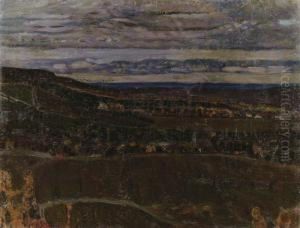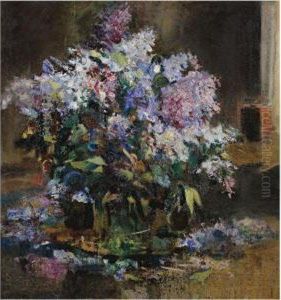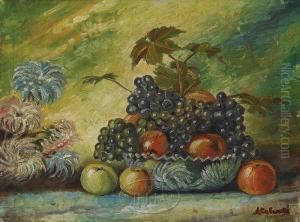Alexander Ivanovitch Savinov Paintings
Alexander Ivanovitch Savinov was a Russian painter, graphic artist, and stage designer, born in Saint Petersburg in 1881. He is associated with the Mir Iskusstva (World of Art) movement, an influential art movement in Russia that sought to break away from the classical traditions and promote artistic individualism and other European modernist styles. Savinov's work spans a variety of mediums, including painting, illustration, and set design, and is characterized by its lyrical quality, attention to detail, and often, a penchant for mythological and historical themes.
Savinov's education in art began at the Imperial Academy of Arts in Saint Petersburg, where he studied under prominent artists of the time. His early career was marked by his involvement with the Mir Iskusstva group, alongside figures such as Alexandre Benois and Leon Bakst, who were instrumental in the revival of interest in Russian cultural heritage and the integration of modernist aesthetics into Russian art. Savinov's artistic output during this period was diverse, contributing illustrations to literary and artistic journals and engaging in stage design for theaters in Russia.
Throughout his career, Savinov remained deeply interested in the cultural and historical past of Russia, which influenced much of his work. He was known for his historical paintings, which often depicted scenes from Russian history with a romantic flair. In addition to his paintings, Savinov's contributions to stage design are noteworthy; he designed sets and costumes for several productions, bringing his distinctive style to the theatrical realm.
The Russian Revolution of 1917 proved to be a turning point for many artists, and Savinov was no exception. The post-revolutionary period saw him navigating the changing artistic landscape of Russia, with the eventual establishment of the Soviet Union introducing new ideological directives in art. Despite these changes, Savinov continued to work and adapt, though like many of his contemporaries, he faced challenges in the increasingly restrictive environment.
Alexander Ivanovitch Savinov passed away in Leningrad (the former Saint Petersburg) in 1942, during the tragic Siege of Leningrad in World War II. His legacy is that of a versatile artist who managed to imprint his distinctive mark on Russian art, traversing the worlds of painting, graphic arts, and theater with equal adeptness. Though perhaps not as widely recognized internationally as some of his contemporaries, Savinov's work remains an important part of the rich tapestry of Russian modernist art.


